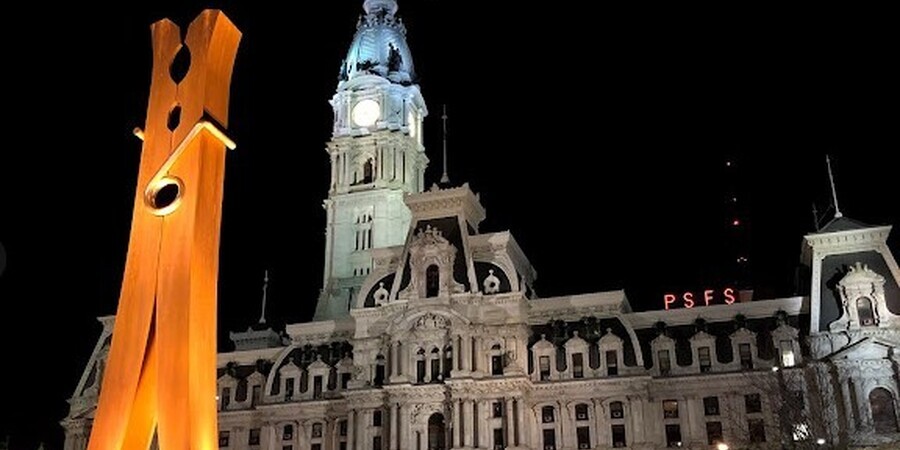Philadelphia, PA
- Across the street from Philadelphia City Hall, a 45-foot steel clothespin stands as an icon for the city. Developer Jack Wolgin commissioned the sculpture as part of the Philadelphia Redevelopment Authority's Percent for Art program. The Percent for Art program requires developers to allocate one percent of new construction costs to art. It has become a widely accepted practice in many U.S. cities.
If you walk through the heart of Center City, Philadelphia, you'll be surrounded by history, from the towering architecture of City Hall to the bustling energy of Dilworth Park. And right in the middle of it all, standing proudly at 15th and Market Streets, you'll find one of the city's most beloved and bewildering icons: a 45-foot-tall, 10-ton steel clothespin.
For decades, this sculpture—simply titled "Clothespin"—has been a popular photo-op for tourists and a daily landmark for commuters. But why is it there? Part of a bold artistic vision, this massive object is one of the most important pieces of public art in Philadelphia.
A Pop Art Icon for a Historic City
The "Clothespin" was commissioned in 1976 to celebrate the city's bicentennial. It was designed by Claes Oldenburg, a Swedish-born American sculptor famous for his leading role in the Pop Art movement. Oldenburg's signature style was creating massive, monumental sculptures of ordinary, everyday objects, from a giant "Trowel" to a colossal "Shuttlecock."
It was installed as the centerpiece of the Centre Square project, a modern complex of two high-rise office towers. The sculpture's placement was intentional, creating a striking contrast between the brand-new, modern art and the ornate, historic City Hall standing directly across the street.
The Real Meaning Behind the Sculpture
While it may just look like a giant laundry tool, Oldenburg infused the sculpture with deep and clever symbolism.
- A "Kiss" for the City of Brotherly Love: Oldenburg saw the shape as two lovers coming together, a "kiss" that symbolized the unity and "brotherly love" for which Philadelphia is named.
- A Nod to 1776: Look at the spring at the top. The shape of the metal spring perfectly forms the numbers "76," a direct and brilliant nod to the 1776 Bicentennial, which was the entire reason for the commission.
- Blending with the City: The sculpture is made of Cor-Ten steel, the same rugged material used for bridges. This steel is designed to weather over time, forming a warm, reddish-brown patina that protects it. Oldenburg even had streaks painted on the steel to mimic the natural grain of a wooden clothespin, an effect that subtly changes as the sun moves across the sky.
How to Visit the Clothespin
Seeing the "Clothespin" is one of the easiest and most "Philly" things a visitor can do.
- Location: You can't miss it. It stands on a raised podium in the courtyard of Centre Square (1500 Market Street), right at the intersection of 15th & Market.
- Getting There: It is located directly above the 15th Street SEPTA subway station and is just steps away from Dilworth Park and City Hall.
- Cost: It is a public piece of art, making it 100% free to visit and photograph 24/7.
Praised by art critics for its soaring silhouette and beloved by the public for its quirky charm, the "Clothespin" has transcended its origins. It's no longer just a statue; it's a true Philadelphia landmark, representing the city's unique blend of history, art, and everyday grit.
Share This Article on Social Media


